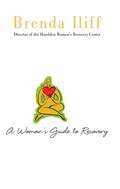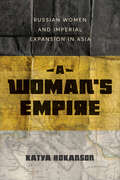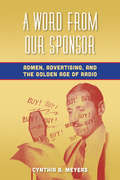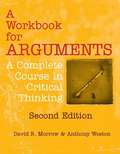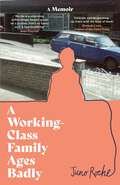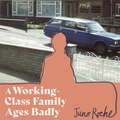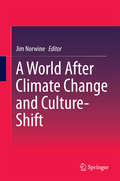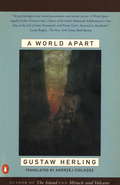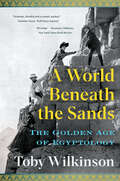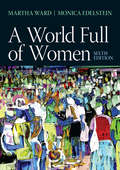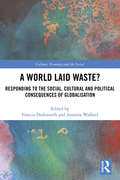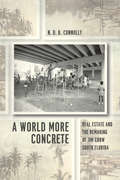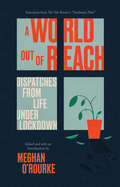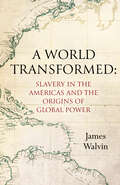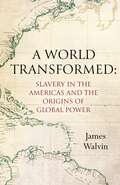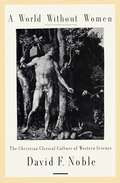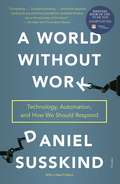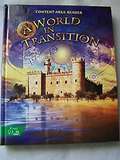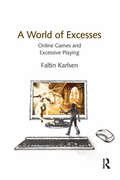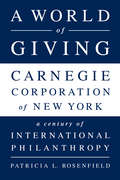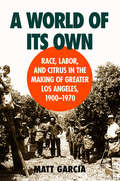- Table View
- List View
A Womans Guide to Recovery
by Brenda IliffThe essential recovery guide for women new to sobriety, written by the director of clinical services at Hazelden's new cutting edge treatment facility for women.Whether you are just embarking down the road of recovery or are well into the journey, consider Brenda Iliff's A Woman's Guide to Recovery your companion and guide. Brenda Iliff is a leading Hazelden clinician. She developed this guide to help women handle issues and challenges that come with their new life of recovery: How can you balance self-care with family responsibilities? What do you do about friends who aren't comfortable with your newfound sobriety? How do you rebuild family relationships? A Woman's Guide to Recovery offers real-life insight into what it means and what it takes to sustain healthy, lasting recovery.
A Woman’s Empire: Russian Women and Imperial Expansion in Asia
by Katya HokansonA Woman’s Empire explores a new dimension of Russian imperialism: women actively engaged in the process of late imperial expansion. The book investigates how women writers, travellers, and scientists who journeyed to and beyond Central Asia participated in Russia’s "civilizing" and colonizing mission, utilizing newly found educational opportunities while navigating powerful discourses of femininity as well as male-dominated science. Katya Hokanson shows how these Russian women resisted domestic roles in a variety of ways. The women writers include a governor general’s wife, a fiction writer who lived in Turkestan, and a famous Theosophist, among others. They make clear the perspectives of the ruling class and outline the special role of women as describers and recorders of information about local women, and as builders of "civilized" colonial Russian society with its attendant performances and social events. Although the bulk of the women’s writings, drawings, and photography is primarily noteworthy for its cultural and historical value, A Woman’s Empire demonstrates how the works also add dimension and detail to the story of Russian imperial expansion and illuminates how women encountered, imagined, and depicted Russia’s imperial Other during this period.
A Word from Our Sponsor: Admen, Advertising, and the Golden Age of Radio
by Cynthia B. MeyersDuring the “golden age” of radio, from roughly the late 1920s until the late 1940s, advertising agencies were arguably the most important sources of radio entertainment. Most nationally broadcast programs on network radio were created, produced, written, and/or managed by advertising agencies: for example, J. Walter Thompson produced “Kraft Music Hall” for Kraft; Benton & Bowles oversaw “Show Boat” for Maxwell House Coffee; and Young & Rubicam managed “Town Hall Tonight” with comedian Fred Allen for Bristol-Myers. Yet this fact has disappeared from popular memory and receives little attention from media scholars and historians. By repositioning the advertising industry as a central agent in the development of broadcasting, author Cynthia B. Meyers challenges conventional views about the role of advertising in culture, the integration of media industries, and the role of commercialism in broadcasting history.Based largely on archival materials, A Word from Our Sponsor mines agency records from the J. Walter Thompson papers at Duke University, which include staff meeting transcriptions, memos, and account histories; agency records of BBDO, Benton & Bowles, Young & Rubicam, and N. W. Ayer; contemporaneous trade publications; and the voluminous correspondence between NBC and agency executives in the NBC Records at the Wisconsin Historical Society. Mediating between audiences’ desire for entertainment and advertisers’ desire for sales, admen combined “showmanship” with “salesmanship” to produce a uniquely American form of commercial culture. In recounting the history of this form, Meyers enriches and corrects our understanding not only of broadcasting history but also of advertising history, business history, and American cultural history from the 1920s to the 1940s.
A Workbook for Arguments: A Complete Course in Critical Thinking, Second Edition
by Anthony Weston David R. MorrowA Workbook for Arguments builds on Anthony Weston’s A Rulebook for Arguments to provide a complete textbook for a course in critical thinking or informal logic. The second edition adds: Updated and improved homework exercises—nearly one third are new—to ensure that the examples continue to resonate with students. Increased coverage of scientific reasoning, demonstrating how scientific reasoning dovetails with critical thinking more generally Two new activities in which students analyze arguments in their original form, as provided in brief selections from the original texts. This edition continues to include: The entire text of Rulebook, supplemented with extensive explanations and exercises. Homework exercises adapted from a wide range of arguments in a wide variety of sources. Practical advice to help students succeed. Model answers to odd-numbered problems, including commentaries on the strengths and weaknesses of selected sample answers and further discussion of some of the substantive intellectual, philosophical, or ethical issues they raise. Detailed instructions for in-class activities and take-home assignments. An appendix on mapping arguments, giving students a solid introduction to this vital skill in constructing complex and multi-step arguments and evaluating them.
A Working-Class Family Ages Badly
by Juno Roche'Delicate and devastating. Up there with the best of them.' HANNAH LOWE, WINNER OF THE COSTA PRIZE'Roche is a charming, unflinchingly honest guide on a journey that's as funny as it is heart-breaking.' JUNO DAWSONHow does an untrained eye recognise the process of dying, when your mind is fixed firmly on living?A radically honest and uplifting memoir about defying death and learning to live.Juno Roche was born into a working-class family in London in the sixties, who dabbled in minor crime. For their father, violence and love lived together; for their mother, addiction was the only way to survive. School was a respite, but shortly after beginning their university course Juno was diagnosed with HIV, then a death sentence.Juno is a survivor; they outlived their diagnosis, got a degree and became an artist. But however hard you try to take the kid out of the family, some scars go too deep; trying to run from AIDS and their childhood threw Juno into dark years of serious drug addiction, addiction often financed by sex work.Running from home eventually took Juno across the sea to a tiny village in Spain, surrounded by mountains. Only once they found a quiet little house with an olive tree in the garden did Juno start to wonder if they had run too far, and whether they have really been searching for a family all along.In an incredibly honest and brave book, Juno takes us through the moments of their life: Mum sending Christmas cards containing Valium, drug withdrawal on a River Nile cruise, overcoming their father's violence and finding their dream house in Spain. Showing immense resilience, Juno's memoir is a book about what it means to stay alive.Emotional, tragic and incredibly funny, A Working-Class Family Ages Badly is an unforgettable must-read memoir for anyone who loves Educated, Deborah Levy and Motherwell.'Full of heart, wit and charm. I'm obsessed with this book.' Travis Alabanza 'So gripping, I had to make myself slow down to appreciate the quality of the writing. Such a powerful story and so beautifully written.' Paul Burston'Utterly unique. Nobody can write with warmth and confrontation the way Juno can.' Tom Rasmussen'Compassionate, dreamlike and deeply moving.' CN Lester 'Should be read by everyone.' Irenosen Okojie 'Juno has always been a literary voice like no one else, scathingly honest and endlessly expansive.' Amelia Abraham
A Working-Class Family Ages Badly: 'Remarkable' The Observer (Karen Pirie #13)
by Juno Roche'An incredibly honest tale of survival, escape and resilience' The Observer 'Roche is a charming, unflinchingly honest guide on a journey that's as funny as it is heart-breaking.' JUNO DAWSONHow does an untrained eye recognise the process of dying, when your mind is fixed firmly on living?A radically honest and uplifting memoir about defying death and learning to live.Juno Roche was born into a working-class family in London in the sixties, who dabbled in minor crime. For their father, violence and love lived together; for their mother, addiction was the only way to survive. School was a respite, but shortly after beginning their university course Juno was diagnosed with HIV, then a death sentence.Juno is a survivor; they outlived their diagnosis, got a degree and became an artist. But however hard you try to take the kid out of the family, some scars go too deep; trying to run from AIDS and their childhood threw Juno into dark years of serious drug addiction, addiction often financed by sex work.Running from home eventually took Juno across the sea to a tiny village in Spain, surrounded by mountains. Only once they found a quiet little house with an olive tree in the garden did Juno start to wonder if they had run too far, and whether they have really been searching for a family all along.In an incredibly honest and brave book, Juno takes us through the moments of their life: Mum sending Christmas cards containing Valium, drug withdrawal on a River Nile cruise, overcoming their father's violence and finding their dream house in Spain. Showing immense resilience, Juno's memoir is a book about what it means to stay alive.Emotional, tragic and incredibly funny, A Working-Class Family Ages Badly is an unforgettable must-read memoir for anyone who loves Educated, Deborah Levy and Motherwell.'Delicate and devastating. Up there with the best of them.' HANNAH LOWE, WINNER OF THE COSTA PRIZE'Full of heart, wit and charm. I'm obsessed with this book.' Travis Alabanza 'So gripping, I had to make myself slow down to appreciate the quality of the writing. Such a powerful story and so beautifully written.' Paul Burston'Utterly unique. Nobody can write with warmth and confrontation the way Juno can.' Tom Rasmussen'Compassionate, dreamlike and deeply moving.' CN Lester 'Should be read by everyone.' Irenosen Okojie 'Juno has always been a literary voice like no one else, scathingly honest and endlessly expansive.' Amelia Abraham
A World After Climate Change and Culture-Shift
by Jim NorwineIn this book, an international team of environmental and social scientists explain two powerful current change-engines and how their effects, and our responses to them, will transform Earth and humankind into the 22nd-century (c. 2100). This book begins by detailing the current state of knowledge about these two ongoing, accelerating and potentially world-transforming changes: climate change, in the form of global warming, and a profound emerging shift of normative cultural condition toward the assumptions and values often associated with so-called postmodernity, such as tolerance, diversity, self-referentiality, and dubiety replaced with certainty. Next, the contributors imagine, explain and debate the most likely consequent transformations of human and natural ecologies and economies that will take place by the end of the 21st-century. In 16 compellingly original, provocative and readable chapters, A World after Climate Change and Culture-Shift presents a one-of-a-kind vision of our current age as a "hinge" or axial century, one driven by the most radical combined change of nature and culture since the rise of agriculture at the end of the last Ice Age some 10 millennia ago. This book is highly recommended to scholars and students of the environmental and social sciences, as well as to all readers interested in how changes in nature and culture will work together to reshape our world and ourselves. "I cannot think of a book more geared to advancing the art and science of geography. " - Yi-Fu Tuan, J. K. Wright and Vilas Professor Emeritus of Geography, University of Wisconsin-Madison"Outstanding," "unique," and "exceptional timeliness of topic and ambition ofvision". - Richard Marston, University Distinguished Professor, Kansas State University; past president, Association of American Geographers
A World Apart: Imprisonment in a Soviet Labor Camp During World War II
by Bertrand Russell Gustaw Herling Andrzej CiolkoszIn 1940, Gustav Herling was arrested after he joined an underground Polish army that fell into Russian hands. He was sent to a northern Russian labour camp, where he spent the two most horrible years of his life. In this book, he tells of the people he was imprisoned with, the hardships they endured, and the indomitable spirit and will that allowed them to survive. Above all, he creates a portrait of how people - deprived of food, clothing, proper medical care, and forced to work at hard labour - can come together to form a community that offers hope in the face of hopelessness, that offers life when even the living have no life left.
A World Beneath the Sands: The Golden Age Of Egyptology
by Toby WilkinsonA thrilling history of the West’s scramble for the riches of ancient Egypt by the foremost Egyptologist of our time. From the decipherment of hieroglyphics in 1822 to the discovery of Tutankhamun’s tomb by Howard Carter and Lord Carnarvon a hundred years later, the uncovering of Egypt’s ancient past took place in an atmosphere of grand adventure and international rivalry. In A World Beneath the Sands, acclaimed Egyptologist Toby Wilkinson chronicles the ruthless race between the British, French, Germans, and Americans to lay claim to its mysteries and treasures. He tells riveting stories of the men and women whose obsession with Egypt’s ancient civilization helped to enrich and transform our understanding of the Nile Valley and its people, and left a lasting impression on Egypt, too. Travelers and treasure-hunters, ethnographers and archaeologists: whatever their motives, whatever their methods, a century of adventure and scholarship revealed a lost world, buried for centuries beneath the sands.
A World Full of Women
by Martha C. Ward Monica D. EdelsteinTakes a cross-cultural approach to the study of womenA World Full of Women, 6/e, combines descriptive ethnography, gender theory, and international statistics to present a comprehensive picture of the lives of women. Readers will better comprehend and contextualize women’s issues and experiences in today’s world. This title explores the diversity of women’s lives from class to culture, with examples ranging from women’s work to marriage patterns, health issues, violence against women, and grassroots organizing.
A World Laid Waste?: Responding to the Social, Cultural and Political Consequences of Globalisation (CRESC)
by Francis Dodsworth Antonia WalfordGlobalisation and neo-liberalism have seen the rise of new international powers, increasingly interlinked economies, and mass urbanisation. The internet, mobile communications and mass migration have transformed lives around the planet. For some, this has been positive and liberating, but it has also been destructive of settled communities and ways of living, ecologies, economies and livelihoods, cultural values, political programmes and identities. This edited volume uses the concept of waste to explore and critique the destructive impact of globalisation and neo-liberalism. By bringing to bear the distinct perspectives of sociologists of class, religion and culture; anthropologists concerned with infrastructures, material waste and energy; and analysts from accounting and finance exploring financialization and supply chains, this collection explores how creative responses to the wastelands of globalisation can establish alternative, at times fragile, narratives of hope. Responding to the tendency in contemporary public and academic discourse to resort to a language of the ‘laid to waste’ or ‘left behind’ to make sense of social and cultural change, the authors of this volume focus on the practices and rhetorics of waste in a range of different empirical settings to reveal the spaces for political action and social imagination that are emerging even in times of polarisation, uncertainty and disillusionment. This inter-disciplinary approach, developed through a decade of research in the ESRC Centre for Research on Socio-Cultural Change (CRESC), provides a distinctive perspective on the ways in which people in very different social and cultural contexts are negotiating the destructive and creative possibilities of recent political and economic change.
A World More Concrete: Real Estate and the Remaking of Jim Crow South Florida
by N. D. B. ConnollyMany people characterize urban renewal projects and the power of eminent domain as two of the most widely despised and often racist tools for reshaping American cities in the postwar period. In A World More Concrete, N. D. B. Connolly uses the history of South Florida to unearth an older and far more complex story. Connolly captures nearly eighty years of political and land transactions to reveal how real estate and redevelopment created and preserved metropolitan growth and racial peace under white supremacy. Using a materialist approach, he offers a long view of capitalism and the color line, following much of the money that made land taking and Jim Crow segregation profitable and preferred approaches to governing cities throughout the twentieth century. A World More Concrete argues that black and white landlords, entrepreneurs, and even liberal community leaders used tenements and repeated land dispossession to take advantage of the poor and generate remarkable wealth. Through a political culture built on real estate, South Florida's landlords and homeowners advanced property rights and white property rights, especially, at the expense of more inclusive visions of equality. For black people and many of their white allies, uses of eminent domain helped to harden class and color lines. Yet, for many reformers, confiscating certain kinds of real estate through eminent domain also promised to help improve housing conditions, to undermine the neighborhood influence of powerful slumlords, and to open new opportunities for suburban life for black Floridians. Concerned more with winners and losers than with heroes and villains, A World More Concrete offers a sober assessment of money and power in Jim Crow America. It shows how negotiations between powerful real estate interests on both sides of the color line gave racial segregation a remarkable capacity to evolve, revealing property owners' power to reshape American cities in ways that can still be seen and felt today.
A World More Concrete: Real Estate and the Remaking of Jim Crow South Florida (Historical Studies Of Urban America Ser.)
by N.D.B. ConnollyMany people characterize urban renewal projects and the power of eminent domain as two of the most widely despised and often racist tools for reshaping American cities in the postwar period. In A World More Concrete, N. D. B. Connolly uses the history of South Florida to unearth an older and far more complex story. Connolly captures nearly eighty years of political and land transactions to reveal how real estate and redevelopment created and preserved metropolitan growth and racial peace under white supremacy. Using a materialist approach, he offers a long view of capitalism and the color line, following much of the money that made land taking and Jim Crow segregation profitable and preferred approaches to governing cities throughout the twentieth century.A World More Concrete argues that black and white landlords, entrepreneurs, and even liberal community leaders used tenements and repeated land dispossession to take advantage of the poor and generate remarkable wealth. Through a political culture built on real estate, South Florida’s landlords and homeowners advanced property rights and white property rights, especially, at the expense of more inclusive visions of equality. For black people and many of their white allies, uses of eminent domain helped to harden class and color lines. Yet, for many reformers, confiscating certain kinds of real estate through eminent domain also promised to help improve housing conditions, to undermine the neighborhood influence of powerful slumlords, and to open new opportunities for suburban life for black Floridians. Concerned more with winners and losers than with heroes and villains, A World More Concrete offers a sober assessment of money and power in Jim Crow America. It shows how negotiations between powerful real estate interests on both sides of the color line gave racial segregation a remarkable capacity to evolve, revealing property owners’ power to reshape American cities in ways that can still be seen and felt today.
A World Not to Come
by Raul CoronadoA shift of global proportions occurred in May 1808. Napoleon Bonaparte invaded Spain and deposed the Spanish king. Overnight, the Hispanic world was transformed forever. Hispanics were forced to confront modernity, and to look beyond monarchy and religion for new sources of authority. A World Not to Come focuses on how Spanish Americans in Texas used writing as a means to establish new sources of authority, and how a Latino literary and intellectual life was born in the New World. The geographic locale that became Texas changed sovereignty four times, from Spanish colony to Mexican republic to Texan republic and finally to a U. S. state. Following the trail of manifestos, correspondence, histories, petitions, and periodicals, Raúl Coronado goes to the writings of Texas Mexicans to explore how they began the slow process of viewing the world as no longer being a received order but a produced order. Through reconfigured publics, they debated how best to remake the social fabric even as they were caught up in a whirlwind of wars, social upheaval, and political transformations. Yet, while imagining a new world, Texas Mexicans were undergoing a transformation from an elite community of "civilizing" conquerors to an embattled, pauperized, racialized group whose voices were annihilated by war. In the end, theirs was a world not to come. Coronado sees in this process of racialization the birth of an emergent Latino culture and literature.
A World Out of Reach: Dispatches from Life under Lockdown
by Meghan O’RourkeIn beautifully written and powerfully thought prose, A World Out of Reach offers a crucial record of COVID-19 and the cataclysmic spring of 2020—a record for us and for posterity—in the arresting voices of poets, essayists, scholars, and health care workers. Ranging from matters of policy and social justice to ancient history and personal stories of living under lockdown, this vivid compilation from The Yale Review presents a first draft of one of the most tumultuous periods in recent history.Contributors: Katie Kitamura • Laura Kolbe • Nitin Ahuja • Rena Xu • Alicia Christoff • Miranda Featherstone • Maya C. Popa • Major Jackson • John Witt • Octávio Luiz Motta Ferraz • Joan Naviyuk Kane • Nell Freudenberger • Briallen Hopper • Brandon Shimoda • Yusef Komunyakaa • Laren McClung • Eric O&’Keefe-Krebs • Sean Lynch • Millicent Marcus • Meghana Mysore • Rachel Jamison Webster • Emily Ziff Griffin • Rowan Ricardo Philips • Kathryn Lofton • Monica Ferrell • Russell Morse • Randi Hutter Epstein • Noreen Khawaja • Victoria Chang • Joyelle McSweeney • Khameer Kidia • Emily Greenwood • Elisa Gabbert • Emily Bernard • Hafizah Geter • Emily Gogolak • Roger Reeves
A World Transformed: Slavery in the Americas and the Origins of Global Power
by James WalvinA comprehensive study of how slavery and enslaved people shaped the modern world. A World Transformed explores how slavery thrived at the heart of the entire Western world for more than three centuries. Arguing that slavery can be fully understood only by stepping back from traditional national histories, this book collects the scattered accounts of the latest modern scholarship into a comprehensive history of slavery and its shaping of the world we know. Celebrated historian James Walvin tells a global story that covers everything from the capitalist economy, labor, and the environment, to social culture and ideas of family, beauty, and taste. This book underscores just how thoroughly slavery is responsible for the making of the modern world. The enforced transportation and labor of millions of Africans became a massive social and economic force, catalyzing the rapid development of multiple new and enormous trading systems with profound global consequences. The labor and products of enslaved people changed the consumption habits of millions––in India and Asia, Europe and Africa, in colonized and Indigenous American societies. Across time, slavery shaped many of the dominant features of Western taste: items and habits or rare and costly luxuries, some of which might seem, at first glance, utterly removed from the horrific reality of slavery. A World Transformed traces the global impacts of slavery over centuries, far beyond legal or historical endpoints, confirming that the world created by slave labor lives on today.
A World Transformed: Slavery in the Americas and the Origins of Global Power
by Professor James WalvinA World Transformed explores how slavery thrived at the heart of the entire Western world for more than three centuries. Arguing that slavery can only be fully understood by stepping back from traditional national histories, this book collects the scattered accounts of the most recent scholarship into a comprehensive history of slavery and its shaping of the world we know. Celebrated historian James Walvin tells a global story that covers everything from the capitalist economy, labor, and the environment, to social culture and ideas of family, beauty and taste.This book underscores just how thoroughly slavery is responsible for the making of the modern world. The enforced transportation and labour of millions of Africans became a massive social and economic force, catalysing the rapid development of multiple new and enormous trading systems with profound global consequences. The labour and products of enslaved people changed the consumption habits of millions - in India and Asia, Europe and Africa, in colonised and Indigenous American societies. Across time, slavery shaped many of the dominant features of Western taste: items and habits or rare and costly luxuries, some of which might seem, at first glance, utterly removed from the horrific reality of slavery. A World Transformed traces the global impacts of slavery over centuries, far beyond legal or historical endpoints, confirming that the world created by slave labour lives on today.
A World Transformed: Slavery in the Americas and the Origins of Global Power
by Professor James WalvinA World Transformed explores how slavery thrived at the heart of the entire Western world for more than three centuries. Arguing that slavery can only be fully understood by stepping back from traditional national histories, this book collects the scattered accounts of the most recent scholarship into a comprehensive history of slavery and its shaping of the world we know. Celebrated historian James Walvin tells a global story that covers everything from the capitalist economy, labor, and the environment, to social culture and ideas of family, beauty and taste.This book underscores just how thoroughly slavery is responsible for the making of the modern world. The enforced transportation and labour of millions of Africans became a massive social and economic force, catalysing the rapid development of multiple new and enormous trading systems with profound global consequences. The labour and products of enslaved people changed the consumption habits of millions - in India and Asia, Europe and Africa, in colonised and Indigenous American societies. Across time, slavery shaped many of the dominant features of Western taste: items and habits or rare and costly luxuries, some of which might seem, at first glance, utterly removed from the horrific reality of slavery. A World Transformed traces the global impacts of slavery over centuries, far beyond legal or historical endpoints, confirming that the world created by slave labour lives on today.
A World Without Women: The Christian Clerical Culture of Western Science
by David F NobleWhy is it that Western science evolved as a thoroughly male-dominated enterprise? As philosopher Sandra Harding has noted, "women have been more systematically excluded from doing serious science than performing any other social activity except, perhaps, frontline warfare. " InA WorldWithout Women, David F. Noble provides the first full-scale investigation of the origins and implications of the masculine culture of Western science and technology, and in the process offers some surprising revelations. Noble begins by showing that, contrary to the widely held notion that the culture of learning in the West has always excluded women--an assumption that rests largely upon the supposed legacy of ancient Greece--men did not thoroughly dominate intellectual life until the beginning of the second millennium of the Christian era. At this time science and the practices of higher learning became the exclusive province of the newly celibate Christian clergy, whose ascetic culture denied women a place in any scholarly enterprise. By the twelfth century, papal reform movements had all but swept away the material and ideological supports of future female participation in the world of learning; as never before, women were on the outside looking in. Noble further demonstrates that the clerical legacy of a world without women remained more or less intact through the Reformation, and permeated the emergant culture of science. A World Without Womenfinally points to a dread of women at the core of modern scientific and technological enterprise, as these disciplines work to deprive one-half of humanity of its role in production (as seen in the Industrial Revolution's male appropriation of labor) and reproduction as well (the age-old quest for an artificial womb). It also makes plain the hypocrisy of a community that can honor a female scientist with a bronze bust, as England's Royal Society did for Mary Somerville in the mid-nineteenth century, yet deny her entry to the very meeting hall in which it enjoyed pride of place. An important and often disturbing book,A World Without Womenis essential reading for anyone concerned not only about the world of science, but about the world that science has made.
A World Without Work: Technology, Automation, and How We Should Respond
by Daniel SusskindA New York Times Book Review Editors’ ChoiceFrom an Oxford economist, a visionary account of how technology will transform the world of work, and what we should do about itFrom mechanical looms to the combustion engine to the first computers, new technologies have always provoked panic about workers being replaced by machines. For centuries, such fears have been misplaced, and many economists maintain that they remain so today. But as Daniel Susskind demonstrates, this time really is different. Breakthroughs in artificial intelligence mean that all kinds of jobs are increasingly at risk.Drawing on almost a decade of research in the field, Susskind argues that machines no longer need to think like us in order to outperform us, as was once widely believed. As a result, more and more tasks that used to be far beyond the capability of computers – from diagnosing illnesses to drafting legal contracts, from writing news reports to composing music – are coming within their reach. The threat of technological unemployment is now real.This is not necessarily a bad thing, Susskind emphasizes. Technological progress could bring about unprecedented prosperity, solving one of humanity’s oldest problems: how to make sure that everyone has enough to live on. The challenges will be to distribute this prosperity fairly, to constrain the burgeoning power of Big Tech, and to provide meaning in a world where work is no longer the center of our lives. Perceptive, pragmatic, and ultimately hopeful, A World Without Work shows the way.
A World in Transition: The Fall of Rome to the Early Modern Era (Content-Area Reader)
by Judith IrvinUsing real life illustrations and events, the book takes the student through the history of Rome, including the lives of its leaders, culture, art and battles.
A World of Excesses: Online Games and Excessive Playing
by Faltin KarlsenThis book explores gaming culture, focusing on competent players and excessive use. Addressing the contested question of whether addiction is possible in relation to computer games - specifically online gaming - A World of Excesses demonstrates that excessive playing does not necessarily have detrimental effects, and that there are important contextual elements that influence what consequences playing has for the players. Based on new empirical studies, including in-depth interviews and virtual ethnography, and drawing on material from international game related sites, this book examines the reasons for which gaming can occupy such a central place in people's lives, to the point of excess. As such, it will be of interest to sociologists and psychologists working in the fields of cultural and media studies, the sociology of leisure, information technology and addiction.
A World of Gangs: Armed Young Men and Gangsta Culture (Globalization and Community #14)
by John M. Hagedorn&“Street gangs mirror the inhuman ambitions and greed of society&’s trendsetters and deities even as they fight to the death over scraps from the table of the international drug trade. But John Hagedorn, characteristically, also finds hope in the contradictory values of outlaw youth—selflessness, solidarity, and love amid cupidity and directionless rage—and he maintains the hope that a culture of resistance will ultimately prevail over the forces of self-destruction. Whether one shares his optimism or not, he makes a compelling case that the future of the world will be determined on the streets of our cities.&” —Mike Davis, from the Foreword &“A World of Gangs is an illuminating journey around the cultures, lives, tragedies, and dreams of millions of rebellious youth around the planet. It is an indispensable work to understand the world we live in and essential reading for students of cities and communities.&” —Manuel Castells For the more than a billion people who now live in urban slums, gangs are ubiquitous features of daily life. Though still most closely associated with American cities, gangs are an entrenched, worldwide phenomenon that play a significant role in a wide range of activities, from drug dealing to extortion to religious and political violence. In A World of Gangs, John Hagedorn explores this international proliferation of the urban gang as a consequence of the ravages of globalization. Looking closely at gang formation in three world cities-Chicago, Rio de Janeiro, and Capetown-he discovers that some gangs have institutionalized as a strategy to confront a hopeless cycle of poverty, racism, and oppression. In particular, Hagedorn reveals, the nihilistic appeal of gangsta rap and its street ethic of survival &“by any means necessary&” provides vital insights into the ideology and persistence of gangs around the world. This groundbreaking work concludes on a hopeful note. Proposing ways in which gangs might be encouraged to overcome their violent tendencies, Hagedorn appeals to community leaders to use the urgency, outrage, and resistance common to both gang life and hip-hop in order to bring gangs into broader movements for social justice. John M. Hagedorn is associate professor of criminal justice at the University of Illinois, Chicago. He is editor of Gangs in the Global City and author of the highly influential People and Folks: Gangs, Crime, and the Underclass in a Rustbelt City. MacArthur fellow Mike Davis is the author of many books, including Planet of Slums and, most recently, Buda&’s Wagon: A Brief History of the Car Bomb.
A World of Giving: Carnegie Corporation of New York-A Century of International Philanthropy
by Patricia L. RosenfieldThe age of international philanthropy is upon us. Today, many of America’s most prominent foundations support institutions or programs abroad, but few have been active on the global stage for as long as Carnegie Corporation of New York. A World of Giving provides a thorough, objective examination of the international activities of Carnegie Corporation, one of America’s oldest and most respected philanthropic institutions, which was created by steel baron Andrew Carnegie in 1911 to support the "advancement and diffusion of knowledge and understanding. ” The book explains in detail the grantmaking process aimed at promoting understanding across cultures and research in many nations across the world. A World of Giving highlights the vital importance of Carnegie Corporation’s mission in guiding its work, and the role of foundation presidents as thought and action leaders. The presidents, trustees, and later on, staff members, are the human element that drives philanthropy and they are the lens through which to view the inner workings of philanthropic institutions, with all of their accompanying strengths and limitations, especially when embarking on international activities. It also does not shy away from controversy, including early missteps in Canada, race and poverty issues in the 1930s and 1980s related to South Africa, promotion of area studies affected by the McCarthy Era, the critique of technical assistance in developing countries, the century-long failure to achieve international understanding on the part of Americans, and recent critiques by Australian historians of the Corporation’s nation-transforming work there. This is a comprehensive review of one foundation’s work on the international stage as well as a model for how philanthropy can be practiced in a deeply interconnected world where conflicts abound, but progress can be spurred by thoughtful, forward-looking institutions following humanistic principles.
A World of Its Own
by Matt GarciaTracing the history of intercultural struggle and cooperation in the citrus belt of Greater Los Angeles, Matt Garcia explores the social and cultural forces that helped make the city the expansive and diverse metropolis that it is today.As the citrus-growing regions of the San Gabriel and Pomona Valleys in eastern Los Angeles County expanded during the early twentieth century, the agricultural industry there developed along segregated lines, primarily between white landowners and Mexican and Asian laborers. Initially, these communities were sharply divided. But Los Angeles, unlike other agricultural regions, saw important opportunities for intercultural exchange develop around the arts and within multiethnic community groups. Whether fostered in such informal settings as dance halls and theaters or in such formal organizations as the Intercultural Council of Claremont or the Southern California Unity Leagues, these interethnic encounters formed the basis for political cooperation to address labor discrimination and solve problems of residential and educational segregation. Though intercultural collaborations were not always successful, Garcia argues that they constitute an important chapter not only in Southern California's social and cultural development but also in the larger history of American race relations.
